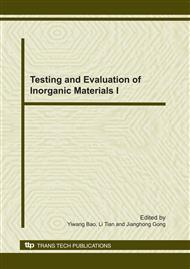p.201
p.204
p.208
p.211
p.215
p.219
p.223
p.226
p.231
Depolarization Behavior of Lead-Free (Bi1/2Na1/2)TiO3-Based Ferroelectrics with Different Li+ Introduction Sources
Abstract:
Lead-free 0.85(Bi1/2Na1/2)TiO3- 0.10(Bi1/2K1/2)TiO3- 0.05BaTiO3 (BNKB) ceramics with Li2CO3 or (Bi1/2Li1/2)TiO3 (BLT) added were fabricated by a conventional solid oxide route. The XRD analysis indicates that Li2CO3 introduction leads to the increasing of fraction of tetragonal phase while the BLT introduction does in a reverse tendency. Meanwhile, the depolarization temperature Td of Li2CO3-added BNKB ceramics was enhanced obviously while that of BLT-added BNKB ceramics went down as the addition amount increased. The similarity in variation of the phase structure and the Td of BNKB ceramics reveals the nature of Li+ introduction source on phase structure in BNKB ceramics.
Info:
Periodical:
Pages:
215-218
Citation:
Online since:
December 2010
Authors:
Price:
Сopyright:
© 2011 Trans Tech Publications Ltd. All Rights Reserved
Share:
Citation:


